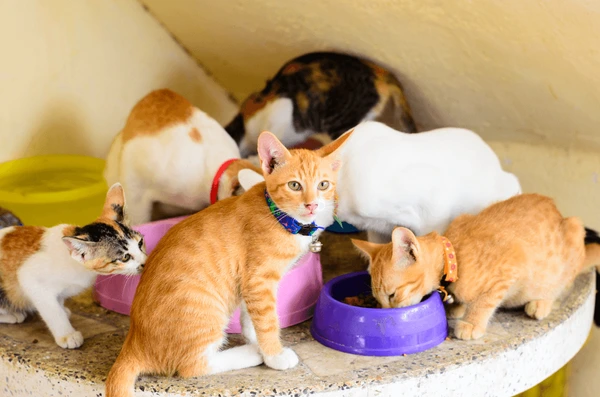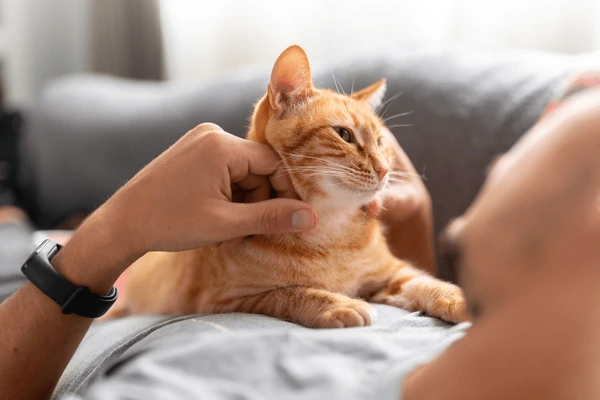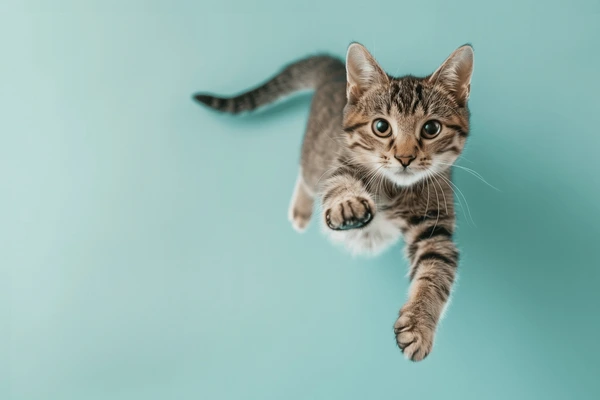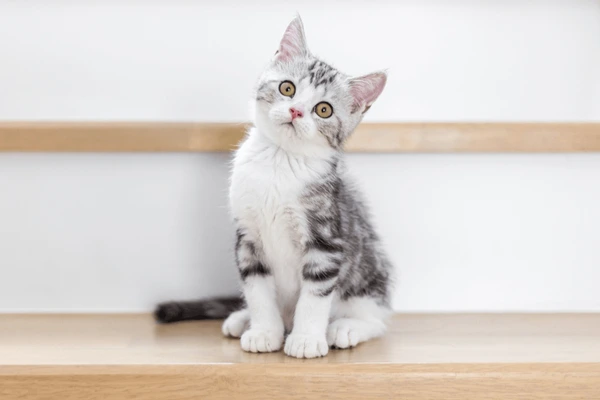What Can Cats See in Color?
What Can Cats See in Color? Cats possess so many unique qualities that make them pretty interesting creatures. Amongst the most fascinating must be their vision. Many cat owners must wonder just what life looks like to the feline friend sleeping on the couch next to them. Do cats see the world in black and white, or do they see colours like humans? Understanding how cats see color can make them make more sense, along with their behavior, hunting instincts, and overall interactions with their environment. In this article, we will dive deep into what the color spectrum the cats can see means, what that does in their daily life, and how their vision works differently than ours.

Key Takeaways
- 1) Cats are not totally colorblind, but they do perceive colors less vibrant than our own.
2) They mainly see the world in blues and greens and cannot distinguish reds.
3) Feline eyes are rather more adapted to a nocturnal hunt environment, in which they see hundreds of times better at night than humans do.
*Knowing more about the cat’s eyes gives us a sense of what their environment needs to be enhanced.
What is Color Vision?
So, first, let’s understand how color vision works. Just about every mammal and human have photoreceptor cells in the eye known as cones that help see color. In a human, there are three types of cones that enable us to see a vast array of colors: red, green, and blue. This combination of the cones allows us to see the rich and diverse colors we experience.
But cats have fewer cones than humans do, so the color sight is a bit more limited. Cats aren’t necessarily colorblind per se, but they don’t see everything in a human’s range of colors either. So let’s get into the nitty-gritty of the types of colors that cats do and don’t see.
The Colors Cats Can See: The Feline Color Spectrum
While humankind can view multiple millions of colors due to the three types of cones in their eyes, cats only have two, which makes them dichromatic. This means they can only see two types, and they cannot view the others.

Blues and Greens: The Dominant Colors for Cats
Cats are able to see shades of blue and green, but this color range is not as sharp for them. The colors appear as washed-out colors to them, but they do still distinguish between variations in the blue-green spectrum. For example, a cat might be able to distinguish between a very bright blue and a pale green object.
Red and Orange: A World of Grays
One of the biggest negatives about cat vision is that they are blind to red, orange, or pink. These colours are probably translated into forms of grayish intensity for cats. The reason is because cats are without cone cells sensitive to the wavelength of light in the red spectrum. Therefore, while to you a red toy appears bright and rainbow-colored, it’s just some vague thing in shades of gray to your cat.
Yellow: A Murky Color
Cats can perceive yellow, even when they are at their best, but it is by no means an experience to which they respond as humans do. Least known how sharp it is, many believe yellow end up in the blue-green spectrum so that cats feel it as a fainter phenomenon.
The Differences Between Feline and Human Vision
While cats may not see many of the colors we do, there is a lot more to the difference between feline and human vision. Cats are crepuscular hunters, meaning they can be most active in the early morning and late in the evening. This affects the eye to adjust to the scene to be viewed, consequently.
Night Vision: Excellent at Low Illumination Levels
Cats have an incredible ability to see in dim light conditions. The eyes contain a higher number of rod cells, which detect photoreceptors and determine the amount of light and not the color. The effectiveness of night vision gives them the capacity to work much better in near darkness and captures the prey there. In fact, cats can see six to eight times better in low light than human beings.
Motion Detection: Quick Reflexes and Fast Reactions
Other than this, motion sensitivity is another one of the main advantages of cat’s vision. They can very easily sense the movement of an object; especially in low light conditions. This high sensitivity towards motion helps them snatch their prey or detect any danger when there is least amount of light available in the surroundings. This is one the vital evolutionary features that helped them become accomplished hunters throughout millions of years.
Field of View: A Greater View
Actually, cats have a wider field of vision than that of man. While man’s field of view has about 180 degrees, the feline can extend theirs almost to about 200 degrees. This wider field of view would make it easier for them to catch movement at the wider angle as they scan their surroundings for hunting or safety.

How You, a Pet Owner, Benefit by Understanding Cat Vision
Knowing how your cat sees the world can help make the environment and activities the cat will be in, better suit your cat’s natural ability. Here are a few practical ways in which knowing feline vision can improve your cat’s well-being:
1. Choosing appropriate toys
Since cats have a poor vision of reds and oranges, they might not be that excited to play with toys that are those colors. Try the toys using the colors visible to them, such as blue and green. This simple change may be the big improvement your feline needs to have fun time playing.
2. Improve Their Surroundings
An environment that is appropriately geared for a cat’s visual strength may make them more comfortable and secure. For instance, hiding places can be identified in dim light, satisfying their instinctive desire for safety. In addition, colors visible to them such as blues and greens can be used in rooms where they spend a lot of their times adding enrichment.
3. Get to Understand Their Behavioral Pattern During Night
While cats are natural nocturnals, their superior night vision is a good reason why it often appears as though they are more active later in the day. Offering your cat safe spaces to wander and explore during the night hours will help them act on their energetic impulses in ways that are instinctual for them.
Facts about Cats Falling Apart: Common Myths about Cat Vision
There are some established myths about cat vision that have been completely fact-checked through scientific study. Let’s dispel some of these myths:

Myth 1: Cats’ Black and White World
Cats cannot see colors as vividly as humans, but cats do not seem to be totally colourblind either. The facts that we discussed above, cats can see blue and green, though their spectrum is not as colorful as ours.
Myth 2: Cats Have Perfect Night Vision
Although cats can see very well at night, they cannot see in absolute darkness. Still, they need some level of illumination to be able to see. However, just like it is a fraction of what the human eye needs.
The Science of Seeing
Cats eyes have developed over millions of years for the purpose of being a hunter. They have developed some unique differences that allow them to be as good as they are at seeing in conditions of low light. Cats owe their exceptional low-light vision to the tapetum lucidum, a reflective layer located behind the retina. This is also why quite often the eyes of cats appear to glow when it is dark.
Though their color vision is not much extensive, other senses such as a sharp smell and hearing help cover up the lack of proper colors in view. Thus, they are able to move around more effectively in the environment. Adding this with their ability to see, they make for the best of predators.

FAQs About Cat Vision
Q: Is the vision ability of all cats the same, or does it vary with the different breeds?
A: Generally, all cats have roughly the same vision capabilities, irrespective of the breed. However, some specific conditions or genetic traits might slightly affect individual cats’ eyesight.
Q: Do cats see better than dogs?
A: Cats have slightly better average vision than dogs for night vision and movement detection; however, dogs might have a very slight better color range as they see more shades of yellow and blue.
Q: Can cats see their owners’ faces?
A: Cats are more sensitive to their owners through smell and hearing rather than by sight. Their poorly colored vision and convergence sensitivity toward movement make it even hard for them to see faces like humans do.
Q: Why do cats’ eyes glow in the dark?
A: The glow emanates from the tapetum lucidum, that reflective layer behind the retina, enhancing their night vision by reflecting light back through the retina.
Q: Do cats see television?
A: They can see images on television screens, but they might perceive them differently than humans because of their limited color vision and motion sensitivities. Fast moving objects are likely to be captured by their attention more than static images.

Final Thoughts: The World Through a Cat’s Eyes
Though cats may not see the world with as much vibrancy as humans do, the sight mechanisms are adapted to best facilitate their hunting needs. Low light sensitivity, motion detection, and perception of a few colors are what make cats thrive both in the wild and domestic contexts. Understanding how they perceive the world can guide cat owners to create an increasingly better life for their cats.
With such spaces and activities designed to take full advantage of their visual strength, we will keep our cats happy, healthy, and stimulated. The next time you see your cat leap on a toy or stalk through a dimly lit room, you will really appreciate the fantastic abilities that sculpt their view of the world.


